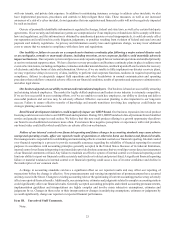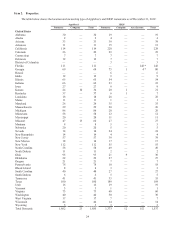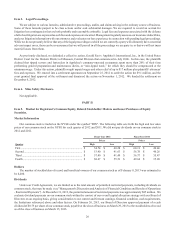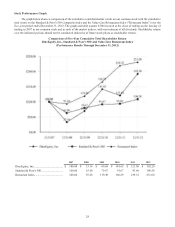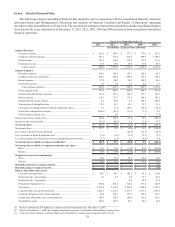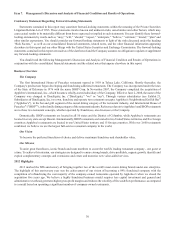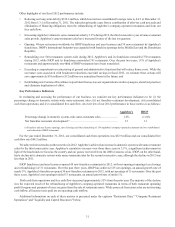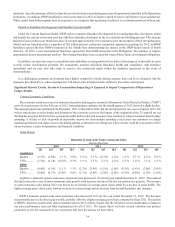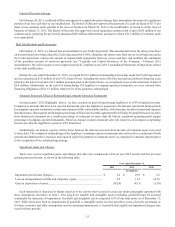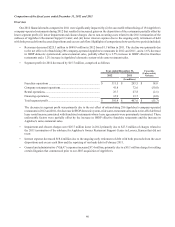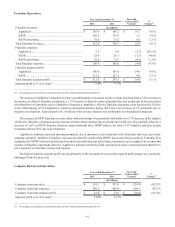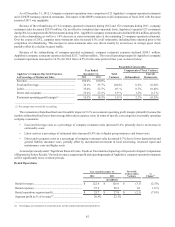IHOP 2012 Annual Report Download - page 51
Download and view the complete annual report
Please find page 51 of the 2012 IHOP annual report below. You can navigate through the pages in the report by either clicking on the pages listed below, or by using the keyword search tool below to find specific information within the annual report.
33
well-qualified management teams. During 2012, we refranchised 154 company-operated restaurants. This highly franchised
business model is expected to require less capital investment and general and administrative overhead, improve overall segment
profit margins and reduce the volatility of cash flow performance.
Improve Margins and Restaurant Level Economics
We have continued to build upon process and system improvements deployed in prior years by improving our operating metrics.
Food inventory management and labor efficiencies were realized during the first half of 2012 in Company-operated restaurants.
These operational improvements helped mitigate the impact of increasing commodity costs and higher payroll expense. We continued
to reap the benefits of our supply chain co-op by leveraging our scale to manage through commodity cost inflation, which was also
mitigated by the realignment of our distribution centers in 2010.
With our transition to a 99% franchised system, restaurant operating margin at the remaining 23 company-operated restaurants
will become less impactful to our results of operations. Given that the primary focus of these restaurants in the future will be to
test new products and processes, their operating margin as a percentage of sales is expected to decline. However, we will continue
to invest in product and process innovation to help our franchisees maintain and improve their restaurant level economics for the
overall financial well-being of the overall Applebee's system.
We continue to monitor our franchisees through our franchisee operations rating system, which provides visibility concerning
their performance in relation to guest experience, food safety and training.
In a challenging economic environment and a highly competitive casual dining category, there can be no assurance that the
strategies described above, when implemented, will achieve the intended results.
IHOP's Key Strategies
To re-ignite growth we have been pursuing key initiatives within the three pillars of our strategic framework: (1) re-energize
and grow the IHOP brand; (2) improve operations performance; and (3) optimize franchise development.
Re-energize and Grow the IHOP Brand
To re-energize and grow the IHOP brand, we are implementing several key initiatives: 1) enhancing our menu; 2) increasing
media effectiveness and 3) improving our advertising. We continuously evolve our menu to maximize consumer acceptance, ease
of use and appeal of the individual items offered. This is an ongoing and continuous process. The expanded "Simple and Fit" line
of items with less than 600 calories and Signature Pancakes line of items are recent examples of this work. Substantially all IHOP
restaurants are using pollable point-of-sale systems to capture and report a broad range of sales and product mix data. This information
is used by management to, among other things, gauge guest acceptance of menu items and the success of promotions and limited
time offers.
Over the years, we have adjusted where and when our advertisements are run to maximize the impact of our advertising dollars.
These decisions are based on market conditions for advertising and an understanding of how best to reach our target customers.
Our focus remains national advertising as we believe this is the best way to drive traffic to our restaurants. Gaining the attention
of consumers in a highly competitive market requires that we constantly update and modify our advertising campaigns to maintain
guest engagement. Recently, we launched a campaign with the “Everything You Love About Breakfast” as the tagline and theme,
accompanied by a “Brandthem” which extols the customer satisfaction gained from dining at IHOP.
Finally, we have increased our efforts in key social media outlets, reflecting the growing importance of these channels. In
2012, we re-launched IHOP.com improving its interactivity and connections with key social media sites. Our e-club, launched in
2010, continues to grow and provide a valuable direct communication channel to a key group of IHOP consumers.
Improve Operations Performance
We constantly strive to improve every aspect of restaurant operations. To enhance our guest-centric culture, and enable our
franchisees to assess and improve their service and the condition of their restaurants, we have developed several new tools that
augment our guest feedback tool, the “Voice of the Guest” program, which provides real-time consumer responses to the operators
and the brand.
In 2012, we implemented an enhanced Operations Evaluations process whereby all IHOP locations are assessed three times
per year on a wide range of operational attributes, allowing franchisees to understand their performance against a set of predetermined


